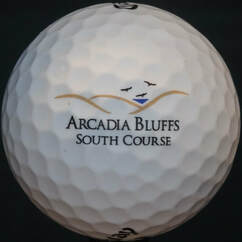
This course has a feature extremely important to me: walkability. Previous greens are in the proximity of the next tee and the elevation changes on the property are not extreme. And the course facilitates walking with a fleet of pull carts if you don't want to put your bag on your shoulder.
I've been a long time fan of the Bluffs Course at Arcadia Bluffs. Opened in 1999 and ranked 13th on Golf Digest's 2017 "America's Greatest Public Courses" list and 36th on Golf Magazine's 2016 "Top 100 You Can Play" list, it's an absolute "must play" course. And now you have two reasons to make the trip as the South Course has made its debut.
I first played the Bluffs Course in 2000 and whenever I'm in northwest Michigan, I try to make it a stop. Sometime in 2016, I learned a second course at Arcadia Bluffs, the South Course, was in the works. It is about a mile south of The Bluffs course and on the east side of M-22. When I last played the Bluffs Course in summer, 2017, the new course had been shaped and plans were in place for a Fall, 2018 opening.
The South Course will have its own clubhouse which was under construction at the time of this writing and scheduled to open late summer of 2019. And more lodging options are in the works.
While the Bluffs Course might beat you up a bit, the South Course is much more playable. Each nine plays in a loop so you will play in all directions, north, south, east, and west during each nine. The fairways are wide and run fast. If you can avoid the many varied bunkers, you will score. With one caveat: the greens are HUGE! Good putters will have an advantage as three and four putts will be common until you understand which zone of the green on which to place your approach shot.
Let me back up a bit and provide some background on the course. The course is built on 311 acres of sandy ground that was once the site of an apple and peach orchard. Resort owner Rich Postma hired architect Dana Fry (who had previously worked on gems Erin Hills and Calusa Pines among others) and partner Jason Straka. Fry recommended the land be cleared and injected with design features in homage to Charles Blair Macdonald and Seth Raynor, titans of early 20th century course design. Rich Postma loved this idea as it just so happens he is a big fan of the Chicago Golf Club, Macdonald's 1896 gem in Wheaton, IL that was later renovated in 1923 by Raynor.
Rectangular tees with sharp right angles.
Huge greens averaging 9400 square feet. Squared-off greens (not every green but you will see greens with right angles - for instance, the second green is square in front with rounded back edges; this green also has a Y-shaped swale through its heart for diverting water but it does a better job of diverting golf balls); a square green with rounded edges facing you like a baseball diamond (the sixth); a rectangular green minus the front left quarter which is consumed by an L-shaped bunker front and left (the eighth); a horseshoe shaped green with a bunker inside the horseshoe (the twelfth); a punch-bowl green with a trench across the surface that's like a Biarritz green (the thirteenth); and a humpback green (the fifteenth). Many of these greens have edges that funnel into green-side bunkers.
There are many flat-floored fairway bunkers, pit and pot bunkers, Spectacle bunkers 50 yards or so short of the ninth green in homage to Carnoustie, even a set of bunkers on the seventeenth hole that mimic Oakmont's church pew bunkers. The bunker faces are not severe. If you end up in a bunker (and it is likely you will on this course), you have a chance to recover. I don't think I saw a bunker deeper than six feet.
Massive fairways (up to 70 yards wide) framed by rows of tall fescue that run and run.
Closely mowed aprons that extend well off the greens that invite all kinds of creative short game options.
The South Course is firm and plays fast. I am in love with this style of course. Think of Chambers Bay, Erin Hills, Sand Valley, Mammoth Dunes, Pacific Dunes, Bandon Dunes, Gamble Sands and Mossy Oak without the elevation changes. Good comparisons from an elevation change and fast/firmness standpoint include Tom Doak's The Loop in Roscommon, MI, his Old Macdonald course in Bandon, OR and his Blue Course at Streamsong in Florida.
Although easier than its sister Bluffs course, the South Course won't be tamed on your first try. It is a course that will not beat you up but it is one that needs to be studied. I fell in love with it during my first loop but I am sure it will need to grow on most golfers.
From a rate standpoint, your best bet is the Fall rate beginning early October with a walk-on rate of $75. During peak summer times, the rate is $160 with a Tuesday senior rate of $100.
All in all, this is a terrific addition to the resort.
 RSS Feed
RSS Feed